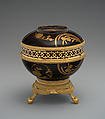Potpourri vessel
attributed to Benjamin Vulliamy British
Not on view
Not intended for export, the Edo period Japanese lacquer bowls were typically made in sets of five and were used for serving warm soup. Although made of turned wood, the many layers of lacquer made the bowls impermeable so that they could be used for liquid food. Many of these bowls were produced in Wajima and their shape reflects those of contemporary porcelain. The maki-e lacquer decoration of flowers within a roundel extends from the bowl to the rimmed cover.
Transforming the lacquer bowls from dinnerware into potpourri holders and elevating them into objets d’art, the mounts are conforming to European taste and possibly are the work of the British firm of clockmakers Vulliamy. This firm was established by François Justin Vulliamy, a successful clockmaker of Swiss origin, who moved to London. in 1730. His eldest son Benjamin (1747–1811) went into business with his father in 1780 (Vulliamy & Son). Father and son worked together until François Justin died on 1 December 1797. Benjamin’s success in his designs for clocks led him to design other luxury items as well, such as inkstands, lighting, as well as metal mounts for other fashionable objects. The high quality of the metalwork certainly suggests the work of an experienced and successful artist as Vulliamy. However, there were other firms making similar mounts in Britain as well, but without a stamp or signature, it is difficult to attribute the mounts to a particular artist or firm.
These beautiful and elegant works of art show the continued appreciation of Asian lacquer in Europe around 1800 as well as the ongoing popularity of using potpourri to scent the interior. A number of similar lacquer potpourri vessels, still in the British Royal Collection, were once at Brighton Pavilion a seaside retreat built for George, Prince of Wales, who became Prince Regent in 1811, and King George IV in 1820. With its fanciful interior design, the pavilion was heavily influenced by both Chinese and Indian fashion, in vogue during the early 19th century.
Due to rights restrictions, this image cannot be enlarged, viewed at full screen, or downloaded.
This artwork is meant to be viewed from right to left. Scroll left to view more.



